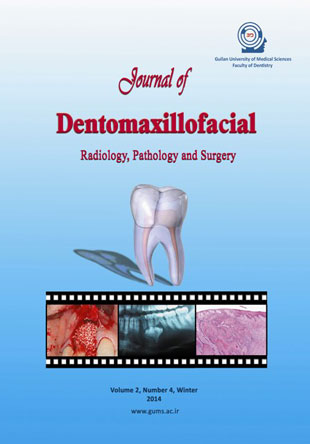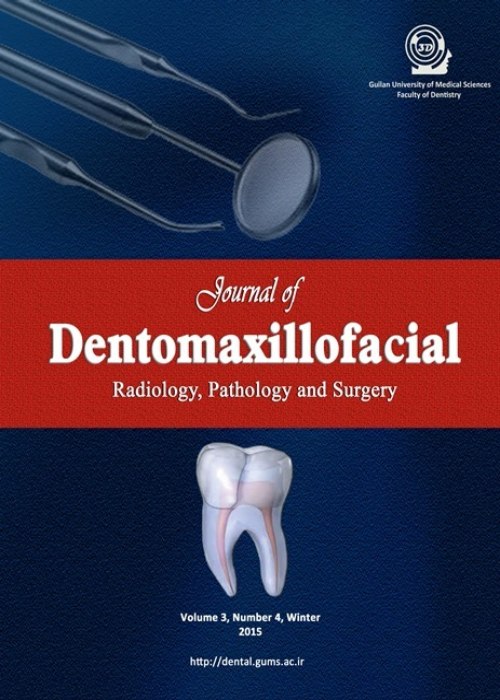فهرست مطالب

Journal of Dentomaxillofacil Radiology, Pathology and Surgery
Volume:2 Issue: 4, Winter 2014
- تاریخ انتشار: 1392/12/18
- تعداد عناوین: 6
-
-
Pages 1-6IntroductionMouthwashes which prevent and control caries and periodontal diseases are commonly used even without professional pre scription. Long-term use of mouth-washes may cause softening of restorative composites and lowering the longevity of restoration. The aim of this study was evaluation of surface hardness value of a microhybride composite (Filtek Z250) after 12 hours immersion in three kinds of alco hol-free mouthwashes.Materials And Methods72 Cylinderical speci-mens of a microhybride composite 5mm wide were prepared, using drinking straw as a mold. Specimens were light-cured continuously for 40 seconds on each side with Elipar(3M,ESPE) cur ing light. The specimens were immersed in 50ml of distilled water for12 hours. After that, all of them were finished with silicone carbide papers under constant water as coolant. The speci mens were divided into 4 groups, each with 18 samples, the first group immersed in Colgate plax, the second in Crest (pro-health for me), group3 in OraCare and group4 in water as the control group for 12 hours, which is equivalent to 1 year of daily mouthwash use at 2 minutes per day. Hardness measurement was taken by Vickers hardness tester with 1 kilogram load and 10 seconds loading time.ResultStatistical analysis according to t-test and One-Way ANOVA test showed that there was no significant difference in surface hard ness value of composite after 12 hours immer sion between groups of mouthwashes and water(P value=0.353)ConclusionBased on the present study, alco-hol-free mouthwashes didn’t affect the surface hardness of Filtek(Z250) composite.Keywords: Mouthwashes, Composite Resins, Hardness Test
-
Pages 7-14IntroductionDiscoloration of resin composites is a common reason for replacement of these restorations. The aim of this study was to eva-luate the influence of different light curing de-vices on color stability of a microhybrid resin composite.Materials And Methods80 disc-shaped speci-mens (8 mm in diameter, 2-mm height) were fabricated from filtek Z250 resin composite. Specimens were divided into 4 groups (n=20) and cured with LED (Bluephase C5, Valo) or QTH (Astralis7 with two different light intensity) light curing devices. Baseline color of each specimen was measured with a spectrophotometer according to the CIE (L*a*b*) color scale. (CIE L*a*b* is a color measurement system with dimension L for lightness and a and b for the color-opponent dimensions). Each subgroup (n=10) were immersed in tea or artificial saliva for 72h at 37°C. The color values of specimens were re-measured and the color change values (ΔE*ab) were calculated using One-Way ANOVA and Tukey test. A P value of <0.05 was considered significant.ResultsIn groups immersed in tea, specimens cured with high power mode of Astralis7 (750mW/cm2), showed the statistically signifi-cant lowest color change. There was no statisti-cally significant difference between two types of Light Emitting Diode units.ConclusionConventional halogen light (QTH) with high power mode showed the maximum color stability in tea.Keywords: Composite Resin, Surface Properties, Color, Halogen Dental Curing Lights, LED Dental Curing Lights
-
Pages 15-22IntroductionSevere early childhood caries is the presence of smooth-surface caries in children younger than three years of age. This rampant form of dental caries exerts a negative impact on the quality of life of both the child and the family. The purpose of this study was to investigate the risk factors for severe early childhood caries (S-ECC) among 2-3 year-old children in Rasht.Materials And MethodsA retrospective, case control study was carried out on 267, 2-3 year-old-children, who were divided into two groups. The study group (cases) included 89 children who were diagnosed with S-ECC. The cases were com pared with the control group including 178 child ren who were caries free. The mothers of children in two groups were asked to fill in a checklist con taining the demographic data, dietary, sleep and oral hygiene habits of the children. Data were statistically analyzed using χ2 test and multiple logistic regression analysis.ResultsStatistical Significant variables associated with S-ECC were breast or bottle feeding to assist with falling asleep at night (P = 0.001), number of nights the child sleep through the night (P< 0.0001), on demand feeding (P < 0.0001), late start of brushing (P = 0.007), frequency of giving sugary snacks (P = 0.016) and the use of a bottle to drink sweetened liquids (P <0.0001). There was no significant relationship between S-ECC and the method, duration of feeding and educa tional level of parents.ConclusionBreast or bottle feeding to assist with falling asleep at night, number of nights the child sleep through the night, on demand feeding, late start of tooth brushing, frequency of giving su gary snacks and the use of a bottle to drink swee tened liquids were identified as risk factors for the development of dental caries in young child ren.Keywords: Child, Dental Caries, Risk Factors
-
Pages 23-28IntroductionDental trauma is a very significant problem in primary dentition. It has a physical, esthetic and psychological impact on the child and his/her parents. The purpose of this study was to assess the prevalence of traumatic inju ries to the anterior primary teeth and deter mining factors in 2-5-year-old children in Rasht, 2012.Materials And MethodsThis research was a cross-sectional study. In order to ex amine for the signs of trauma to their anterior primary teeth, 748 two to five year-old children of kin dergartens in the city of Rasht were chosen. A ques tionnaire regarding the demographic data of their children and history of the trauma were sent to the parents. The statistical analysis was chi-square test.ResultsThe prevalence of traumatic injury to anterior primary teeth was 23.8%, with no sig nificant differences between boys and girls. Enamel fractures were the most common trau matic injury (76.5%). The most common cause, location and seasonal variation of the trauma were respectively falling (95.6%), at home (59.8%) and summer (78.3%). There were more traumas in Children with increased over jet than those with normal or decreased over jet.ConclusionThe dental trauma in primary denti tion is an accident that occurs due to child ren’s development stage, even when they are cared for by mothers at home. There is a need for an edu cational program specifically directed at parents to inform them about the immediate dental treatment in case of traumatic dental injuries.Keywords: Child, Dentition, Primary, Prevalence, Injuries
-
Pages 29-33Dental anomalies are rare findings that may affect development of occlusion and early intervention may be required. Here, a case of multiple anomalies in primary and perma nent dentitions is reported. The patient referred to the dental center with the chief complaint of multiple tooth decay. In the oral examination, the rare case of triplica tion between the right geminated man-dibular A and right mandibular B was observed. A talon cusp on the maxillary deciduous lateral incisor was also noticed. In the panoramic radi-ograph view, two permanent supernumerary teeth were found at the region of primary tooth ano malies in both jaws. The article describes the management of the dentition during the dental transi tory years of 5 to 7. Precise exami nation may reveal anomalies that require inter vention. In some cases, presence of one anomaly in pri mary dentition, can suggest the possibility of further anomalies in both primary and perma nent dentition. In this case, careful initial ex amination and dental panoramic radio graphs led to early diagnosis and appropriate treat ment plans in mixed dentition years.Keywords: Talon Cusp, Triplication, Supernumerary Tooth, Dental Anomaly


